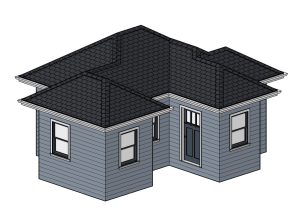Recently, Studica started offering Chief Architect for education. Chief Architect is a CAD program that makes it incredibly easy to design a building from scratch. I recently had the opportunity to sit down with the program and learn my way around it. One of the big new features in Chief Architect X6 is the ability to export your model as an STL file. STL files are one of the most common file types for 3D Printing. If you have a 3D Printer, chances are it prints STL files. In this post, I want to detail how you can export an STL file, fix the file for 3D Printing, and then print the file.
When you prepare a model for 3D Printing, there are certain considerations to take into account if you want your model to print properly. The issue with Chief Architect’s current STL Exporter is that the program does not automatically export a print-ready model. If you export your design as an STL file, you will notice that the model may not be water tight and it may have a lot of non-manifold geometry. Both of these features will result in a problematic print job. This is something that has been brought up on Chief Architect’s forums. Since it is a desirable feature, we can hope that as the software continues to be developed, these issues will be worked out.
Tips for using Chief Architect STL Exporter
In the meantime, however, I have workarounds that should get your STL file printing correctly! Let’s go over the workflow to get from 3D Model to STL file to Printed Object.
1. Design your building in chief architect however you desire. Here’s an example of a poorly designed building that I made.
2. Once you have the model looking the way you like it, go to File → Export →Export 3D Model (STL)… Keep in mind that you need to be in a 3D View in order for this option to be active. Choose a name for the file and save it where you want it.
3. This is probably the most important step. Since Chief Architect’s STL export is likely to have issues, I highly recommend uploading your STL file to Microsoft’s Netfabb cloud site: https://modelrepair.azurewebsites.net/index.php
You will be asked to login with your Microsoft account. If you don’t have one, go ahead and make one; it’s free. Once you’re signed in, click the “Upload” button and choose your STL file. Once that’s done, the service will begin repairing the model. Once it’s finished repairing, click the “Download” option to download the fixed STL file. If you have a working knowledge of 3D Modeling software such as Blender, Maya, 3DS Max, etc. then you could bring the model into those programs and fix it from there. While this may give you more desirable results, it could also take a lot longer to finish.
 4. Once you have the fixed STL file, you should be able to import it into whatever splicer you want to use and print it to your 3D Printer. For the purpose of this post, I imported my STL file into XYZWare for my DaVinci XYZ 1.0 3D Printer. Depending on the software you use, you might want to tweak the settings a bit until you get a model that looks good to you. This was my final print model in XYZWare.
4. Once you have the fixed STL file, you should be able to import it into whatever splicer you want to use and print it to your 3D Printer. For the purpose of this post, I imported my STL file into XYZWare for my DaVinci XYZ 1.0 3D Printer. Depending on the software you use, you might want to tweak the settings a bit until you get a model that looks good to you. This was my final print model in XYZWare.
 5. Now that you’ve done that, you should be able to print it and see the results. Bear in mind that 3D Printing often involves a lot of tweaking to get right. Your first model may not look the way you want. If that’s the case, you will want to go back into your settings and mess around with the different options. You’ll notice in the picture below that my roof didn’t quite turn out very well. This is something I would want to keep in mind the next time I want to print out a model. IT is likely because I did not print with supports so the roof had no material to build itself upon. As such the material became stringy.
5. Now that you’ve done that, you should be able to print it and see the results. Bear in mind that 3D Printing often involves a lot of tweaking to get right. Your first model may not look the way you want. If that’s the case, you will want to go back into your settings and mess around with the different options. You’ll notice in the picture below that my roof didn’t quite turn out very well. This is something I would want to keep in mind the next time I want to print out a model. IT is likely because I did not print with supports so the roof had no material to build itself upon. As such the material became stringy.
In conclusion, the STL exporting in Chief Architect could still use some work. However, with a little bit of tweaking, it is possible to get your model printed the way you want. As the software progresses, I expect that this feature will only get better. I hope you found this helpful. Feel free to leave a comment. Let us know if you have any experience printing STL files from Chief Architect!
Share this Post

